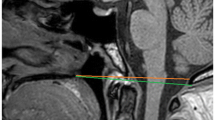Abstract
Background
The craniovertebral junction is an anatomically well-defined transitional zone located between the skull and the cervical spine. Multiple malformations can affect this region with the most prominent being basilar invagination (BI) and Chiari malformation (CM). Despite numerous studies, the origin, pathophysiology, and classification of these pathologies remain controversial. The objective of this study was to evaluate the implication of cranial base flexion angle and clivus length in the development of these conditions.
Methods
Midline tomography and magnetic resonance imaging of normal subjects and patients diagnosed with BI (types I and II) and Chiari malformation were evaluated. A craniometric study of the skull base was performed. Linear and angular measurements were used for comparisons between groups.
Results
109 images from patients with craniovertebral junction malformation and controls were evaluated. Seventeen had BI-I, 26 had BI-II, 36 had CM, and 30 were normal subjects. Demographic data for the two groups were not significantly different. Craniometric analysis of images revealed a gradation in linear and angular variables from controls to CM, BI-I, and BI-II patients. Clivus length was significantly smaller in BI-II patients compared with other groups, while basal angle was greater. Moderate or strong correlations were noted among all variables analyzed.
Conclusion
Data suggest that clivus length and basal angle may play a role in pathophysiology of BI and CM.





Similar content being viewed by others
Abbreviations
- BI:
-
Basilar invagination
- CL:
-
Clivus length
- CM:
-
Chiari malformation
- CVJ:
-
Craniovertebral junction
- CVJM:
-
Craniovertebral junction malformation
- HNFA:
-
Head-neck flexion angle
- CL:
-
Violation of the chamberlain’s line
References
Black SM, Scheuer JL (1996) Occipitalization of the atlas with reference to its embryological development. Int J Osteoarchaeol 6:189–194
Botelho RV, Ferreira EDZ (2013) Angular craniometry in craniocervical junction malformation. Neurosurg Rev 36:604–610
Botelho RV, Ferreira JA, Ferreira EDZ (2018) Basilar Invagination: a craniocervical kyphosis. World Neurosurg 117:180–186
Ferreira EDZ, Botelho RV (2015) Atlas assimilation patterns in different types of adult craniocervical junction malformations. Spine 40:1763–1768
Ferreira JA, Botelho RV (2015) The odontoid process invagination in normal subjects, Chiari malformation and basilar invagination patients: pathophysiologic correlations with angular craniometry. SurgNeurolInt 6:118
Geus CM, Bergman JEH, Ravenswaaij-Arts CMAV, Meiners LC (2018) Imaging of clival hypoplasia in CHARGE syndrome and hypothesis for development: a case-control study. Am J Neuroradiol 39:1938–1942
Goel A (2017) Short neck, short head, short spine, and short body height. Hallmarks of basilar invagination. J Craniovertebr Junction Spine 8:165–167
Goel A, Bhatjiwale M, Desai K (1998) Basilar invagination: a study based on 190 surgically treated patients. J Neurosurg 88:962–968
Goel A, Jain S, Shah A (2018) Radiological evaluation of 510 cases of basilar invagination with evidence of atlantoaxial instability (group A basilar invagination). World Neurosurg 110:533–543
Joaquim AF, Tedeschi H, Chandra PS (2018) Controversies in the surgical management of congenital craniocervical junction disorders – a critical review. Neurol India 66:1003–1015
Menezes AH (2004) Developmental abnormalities of the craniovertebral junction. In: Winn HR (ed) Youman’s Neurological Surgery. Elsevier, Philadelphia, p 3334
Müller F, O’Rahilly R (2003) Segmentation in staged human embryos: the occipitocervical region revisited. J Anat 203:297–315
Nishikawa M, Sakamoto H, Hakuba A, Nakanishi N, Inoue Y (1997) Pathogenesis of Chiari malformation: a morphometric study of the posterior cranial fossa. J Neurosurg 86:40–47
Pang D, Thompson DN (2011) Embryology and bony malformations of the craniovertebral junction. Childs Nerv Syst 27:523–564
Rai R, Iwanaga J, Shokouhi G, Loukas M, Mortazavi MM, Oskouian RJ, Tubbs RS (2018) A comprehensive review of the clivus: anatomy, embryology, variants, pathology, and surgical approaches. Childs Nerv Syst 34:1451–1458
Smith JS, Shaffrey CI, Abel MF, Menezes AH (2010) Basilar Invagination. Neurosurg 66:39–47
Smoker WR (1994) Craniovertebral junction: normal anatomy, craniometry, and congenital anomalies. RadioGraphic 14:255–277
Author information
Authors and Affiliations
Corresponding author
Ethics declarations
This work was conducted in accordance with Brazilian ethical standards (Resolution No. 510, dated April 7, 2016).
Conflict of interest
The authors declare that they have no conflict of interest.
Ethical approval
For this type of study, formal consent is not required.
Additional information
Publisher’s note
Springer Nature remains neutral with regard to jurisdictional claims in published maps and institutional affiliations.
Rights and permissions
About this article
Cite this article
Diniz, J.M., Botelho, R.V. The role of clivus length and cranial base flexion angle in basilar invagination and Chiari malformation pathophysiology. Neurol Sci 41, 1751–1757 (2020). https://doi.org/10.1007/s10072-020-04248-1
Received:
Accepted:
Published:
Issue Date:
DOI: https://doi.org/10.1007/s10072-020-04248-1




